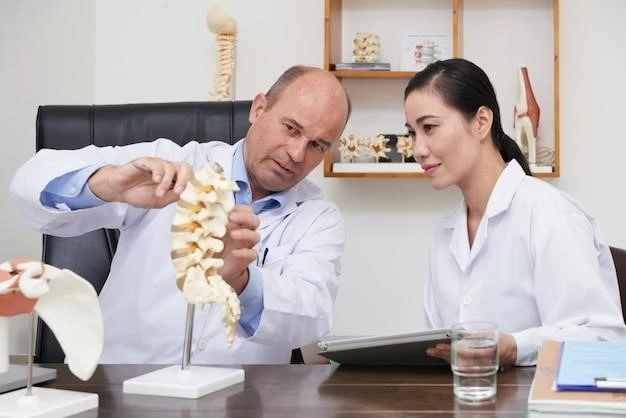Introduction
Neurofibromatosis type 1 (NF1) and neurofibromatosis type 2 (NF2) are inherited disorders affecting multiple systems in the body. Scoliosis is a common complication of NF1, characterized by sideways spinal curvature. Early diagnosis and management are crucial.
Overview of Neurofibromatosis Type 1 (NF1) and Neurofibromatosis Type 2 (NF2)
Neurofibromatosis type 1 (NF1) and neurofibromatosis type 2 (NF2) are inherited neurocutaneous disorders caused by mutations in specific genes, leading to varied multisystem manifestations. NF1 primarily involves benign and malignant tumors, while NF2 affects nerve tissues, bones, and more. This advisory piece emphasizes the importance of understanding the complexities of NF1 and NF2 to navigate the challenges associated with these conditions effectively.
Scoliosis as a Common Complication of NF1
Early diagnosis and management are essential due to the varied manifestations and complications associated with scoliosis in NF1. Understanding the patterns and types of scoliosis in NF1 is crucial for effective treatment.
Prevalence and Patterns of Scoliosis in NF1
The prevalence of scoliosis in NF1 varies but is significant, with patterns including dystrophic and nondystrophic forms. Understanding these patterns is crucial for effective diagnosis and tailored treatment strategies aimed at managing the complications associated with scoliosis in NF1.
Differences Between Scoliosis in NF1 and Idiopathic Scoliosis
Children with NF1 tend to develop scoliosis at an earlier age compared to those with idiopathic scoliosis. The spectrum of scoliosis in NF1 varies from mild nonprogressive forms to severe rapidly progressive forms, with distinct patterns and characteristics that require specialized management techniques tailored to the individual.
Types of Scoliosis in NF1
Scoliosis in NF1 can be categorized into dystrophic scoliosis and nondystrophic scoliosis. Understanding these distinctions is essential for tailored treatment strategies and effective management.
Dystrophic Scoliosis
Dystrophic scoliosis in NF1 typically involves spine abnormalities such as distortion of vertebral bodies and ribs. It is often rapidly progressive, necessitating specialized management approaches for optimal outcomes. Understanding the unique characteristics of dystrophic scoliosis is crucial in providing tailored treatment strategies to address the specific challenges associated with this form of spinal curvature in NF1 patients.
Nondystrophic Scoliosis
Nondystrophic scoliosis in NF1 presents with curvature patterns that do not involve vertebral or rib abnormalities. Management approaches for nondystrophic scoliosis in NF1 often align with those used for idiopathic scoliosis, emphasizing the importance of regular monitoring and appropriate interventions to address the specific needs of each patient.

Management of Scoliosis in NF1
Advisory⁚ Early diagnosis and tailored treatments are crucial for managing scoliosis in NF1 effectively. Understanding dystrophic and nondystrophic types guides appropriate intervention strategies.
Treatment Approaches for Dystrophic Scoliosis
Advisory⁚ Dystrophic scoliosis in NF1 can be challenging due to its rapid progression and spine abnormalities. Specialized management techniques٫ such as operative interventions٫ may be necessary for optimal outcomes. Understanding the unique characteristics of dystrophic scoliosis is crucial in providing tailored treatment strategies to address the specific challenges associated with this form of spinal curvature in NF1 patients.
Treatment Approaches for Nondystrophic Scoliosis
Advisory⁚ Nondystrophic scoliosis in NF1 can often be managed similarly to idiopathic scoliosis, with a focus on monitoring and conservative interventions. Understanding the nuances in managing this type of scoliosis is essential for optimizing treatment outcomes while addressing the specific needs of each patient.
Diagnostic Imaging and Evaluation
Advisory⁚ Imaging plays a crucial role in assessing scoliosis in individuals with NF1. Understanding the role of diagnostic imaging techniques, including CT 3D reconstruction, is essential for evaluating and analyzing spinal curvature accurately.
Role of Imaging in Assessing NF1-Associated Scoliosis
Imaging techniques are essential for evaluating and analyzing scoliosis in individuals with NF1. Understanding the role of diagnostic imaging, including CT 3D reconstruction, is crucial for accurate assessment and effective management of spinal curvature in NF1 patients.
CT 3D Reconstruction in Analyzing Scoliosis in NF1
Advisory⁚ CT 3D reconstruction is a valuable tool for analyzing scoliosis in individuals with NF1. This advanced imaging technique aids in detailed evaluation, providing essential information for accurate assessment and personalized treatment planning to effectively manage spinal curvature in NF1 patients.

Prognosis and Complications
Advisory⁚ Understanding the natural history of scoliosis in NF1 patients and being aware of potential complications associated with severe scoliosis are essential for comprehensive management and optimal outcomes. Regular monitoring and early intervention play a key role in addressing these challenges effectively.
Natural History of Scoliosis in NF1
Advisory⁚ Understanding the progression and characteristic patterns of scoliosis in individuals with NF1 is crucial for determining appropriate treatment strategies. Monitoring the natural course of scoliosis and being aware of potential complications are essential for optimizing patient care and outcomes.
Complications Associated with Severe Scoliosis in NF1
Advisory⁚ Severe scoliosis in NF1 can lead to various complications, including respiratory issues, cardiac abnormalities, neurological complications, and psychological effects. Early intervention and comprehensive management strategies are essential to mitigate these complications and improve quality of life for individuals with severe scoliosis in the context of NF1.
Research Findings and Studies
Advisory⁚ Retrospective studies provide insights into scoliosis in NF1 patients, guiding characteristics, management strategies, and surgical implications. Clinical studies offer valuable data for tailored treatment approaches.
Retrospective Studies on Scoliosis in NF1 Patients
Advisory⁚ Retrospective studies offer valuable insights into the demographic characteristics, incidence of dystrophic features, and surgical risks in NF1 patients with scoliosis. Understanding the findings from these studies can help in tailoring treatment plans for individuals with NF1 and associated spinal pathology.
Characteristics and Management Strategies from Clinical Studies
Advisory⁚ Clinical studies provide valuable insights into the demographics, characteristics, and management approaches for patients with scoliosis in the context of NF1. Utilizing the findings from these studies can inform personalized treatment plans and enhance patient care for individuals with NF1-associated spinal curvature.
Advisory⁚ Analyzing research findings and clinical studies aids in tailoring management strategies and treatment plans for individuals with scoliosis in the context of NF. Stay informed for optimal care.
Key Takeaways on Scoliosis as Part of NF1
Advisory⁚ The management of scoliosis in the context of NF1 requires a tailored approach based on the type of scoliosis present, understanding the natural history, potential complications, and utilizing findings from research studies and clinical data for personalized treatment plans.
